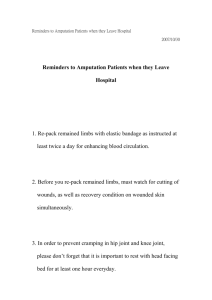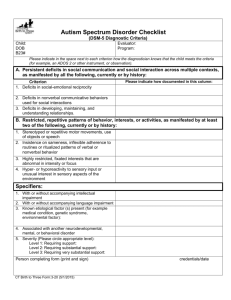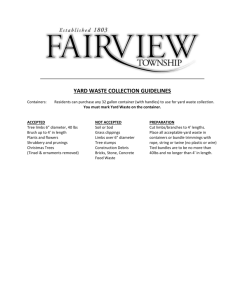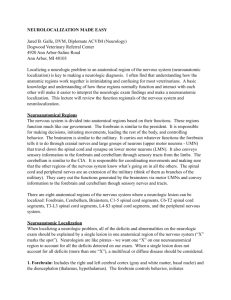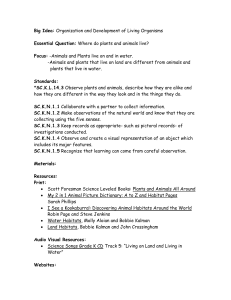Neurological Examination in the Horse
advertisement
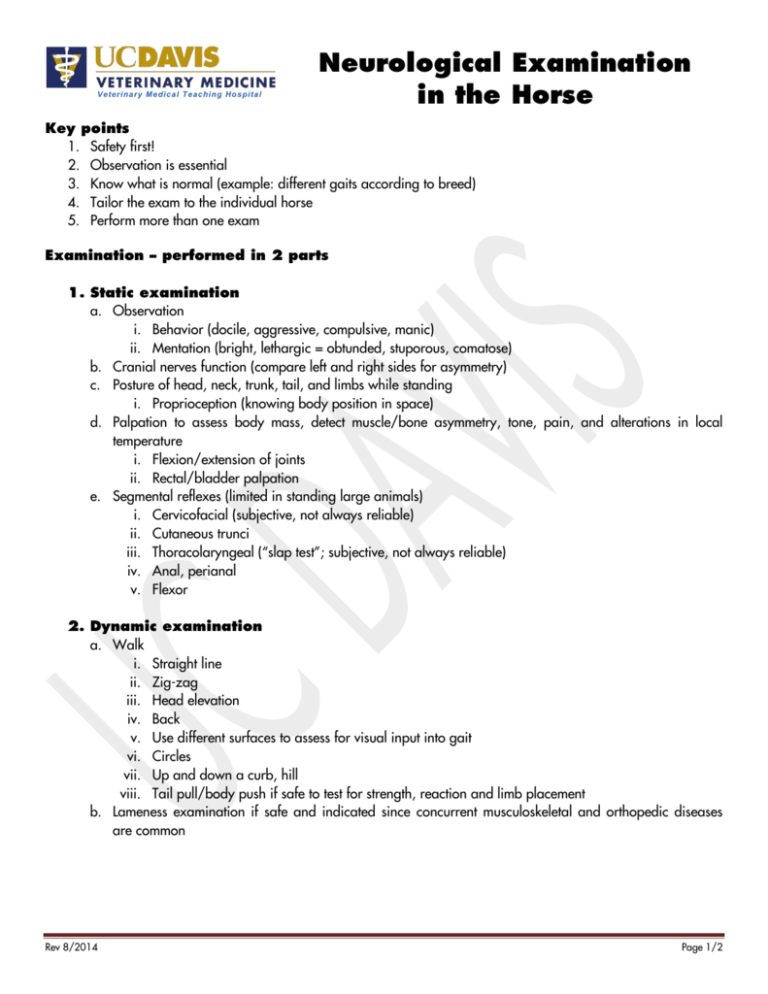
Veterinary Medical Teaching Hospital Neurological Examination in the Horse Key points 1. Safety first! 2. Observation is essential 3. Know what is normal (example: different gaits according to breed) 4. Tailor the exam to the individual horse 5. Perform more than one exam Examination – performed in 2 parts 1. Static examination a. Observation i. Behavior (docile, aggressive, compulsive, manic) ii. Mentation (bright, lethargic = obtunded, stuporous, comatose) b. Cranial nerves function (compare left and right sides for asymmetry) c. Posture of head, neck, trunk, tail, and limbs while standing i. Proprioception (knowing body position in space) d. Palpation to assess body mass, detect muscle/bone asymmetry, tone, pain, and alterations in local temperature i. Flexion/extension of joints ii. Rectal/bladder palpation e. Segmental reflexes (limited in standing large animals) i. Cervicofacial (subjective, not always reliable) ii. Cutaneous trunci iii. Thoracolaryngeal (“slap test”; subjective, not always reliable) iv. Anal, perianal v. Flexor 2. Dynamic examination a. Walk i. Straight line ii. Zig-zag iii. Head elevation iv. Back v. Use different surfaces to assess for visual input into gait vi. Circles vii. Up and down a curb, hill viii. Tail pull/body push if safe to test for strength, reaction and limb placement b. Lameness examination if safe and indicated since concurrent musculoskeletal and orthopedic diseases are common Rev 8/2014 Page 1/2 Veterinary Medical Teaching Hospital Neurological Examination in the Horse Grading System for Ataxia According to Mayhew’s grading system, there are 5 grades: Grade 0: Normal strength and coordination Grade 1: Subtle neurological deficits only noted under special circumstances but mild (e.g. while walking in circles) Grade 2: Mild neurological deficits but apparent at all times/gaits Grade 3: Moderate deficits at all times/gaits that are obvious to all observers regardless of expertise Grade 4: Severe deficits with tendency to buckle, stumble spontaneously, and trip and fall. Grade 5: Recumbent, unable to stand Nociception Pain perception must be tested ONLY in horses with no obvious voluntary motor function. Neuroanatomical Localization The major divisions of the nervous system: - Brain, spinal cord, peripheral - Autonomous nervous system (parasympathetic, sympathetic, intrinsic enteral) 1. Brain a. Forebrain signs: Behavior alterations, altered sleep, seizures, lack of initiation of movement, ignoring one side of the head and body b. Brainstem signs: Altered mental status (obtunded, stuporous, comatose), altered sleep, multiple cranial nerve deficits, and/or central vestibular disease c. Cerebellum signs: Intention tremors, hypermetria of limbs (pronounced in thoracic limbs), ataxia, +/- menace deficits 2. Spinal cord: Gait deficits such as ataxia, paresis and upper motor neuron (UMN*) or lower motor neuron (LMN*) deficits depending on location within specific spinal cord segments: C1-C5/6/7 UMN deficits (normal to exaggerated) of thoracic and pelvic limbs. C6-T2 LMN signs of thoracic limbs, UMN of pelvic limbs. T3-L3 Normal thoracic limbs, UMN of pelvic limbs. L4-S1 Normal thoracic limbs, LMN of pelvic limbs. S-caudal Normal thoracic limbs, normal or LMN of pelvic limbs depending on location, and cauda equina signs (e.g. urinary +/- rectal incontinence) *UMN signs: exaggerated (hypermetric) gait, exaggerated reflexes, increased muscle tone *LMS signs: weakness, dragging feet, reduced to absent reflexes, decreased muscle tone 3. Peripheral nervous system: Gait deficits are specific to nerves affected. 4. Lower motor neuron signs: Weakness, paresis, decreased to absent muscle tone and reflexes A multifocal localization can refer to multiple locations within the brain or spinal cord, or brain and spinal cord, or brain, spinal cord and peripheral nervous system. Equine protozoal myelitis or myeloencephalomyelitis is an example of asymmetrical multifocal central nervous system disease. Rev 8/2014 Page 2/2


